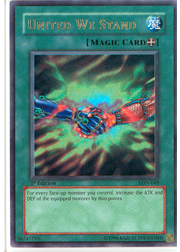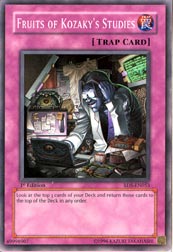 This week I’ll discuss the art of group playtesting. I say "art" because there’s a degree of finesse involved in the process. Why? Well . . . testing is easy when it’s just you and a partner. Mutual agreements are easy to reach and the logistical challenges are minor at best. I think most of you know what happens when you start inviting your friends for any kind of organized testing. You start hearing complaints at first: "I want to play this deck instead." "Why are we doing this again?" Then, some of your friends get bored. "Hey, let’s get some food, then watch a movie." "This is boring. Why do we have to test like this anyway?"
This week I’ll discuss the art of group playtesting. I say "art" because there’s a degree of finesse involved in the process. Why? Well . . . testing is easy when it’s just you and a partner. Mutual agreements are easy to reach and the logistical challenges are minor at best. I think most of you know what happens when you start inviting your friends for any kind of organized testing. You start hearing complaints at first: "I want to play this deck instead." "Why are we doing this again?" Then, some of your friends get bored. "Hey, let’s get some food, then watch a movie." "This is boring. Why do we have to test like this anyway?"
Good testing groups are one-in-a-million in any game, especially this one. The honest truth is that most people don’t know how to test properly for tournaments and the problem is worse with group testing. The general perception of testing is that you get a bunch of friends together, play your favorite decks, bounce around ideas, and somehow you’ll get results. Is it any wonder why only a select few keep performing well at Shonen Jumps? The "somehow" is never explained fully. If you’ve read the Metagame Manifesto, you have a proper framework for testing, but that article was written for one-on-one testing. It doesn’t address the most common problems related to this type of training: communication, group-testing methods, and cultivating the habit.
What We’ve Got Here Is Failure to Communicate!
The benefits of group testing are numerous. The largest benefit is the quality of the results. When you’ve got the proper objective framework, having many brains working on the same deck problem can produce fine-tuned builds. That’s the ideal scenario, but often what ends up happening is vastly different. You get squabbling, politics, and bruised egos. How do you avoid the manifold issues you’ll encounter? Good communication. Let’s elaborate.
First, it’s important to decide what to test in advance and relay that to the group. I can tell you from experience that just showing up
"ready to play" is definitely not enough. It’s very easy to get off track. Like any meeting that the attendees expect to go smoothly, a clear and concise agenda works wonders. Next, you agree on a place to test that is within a reasonable driving distance. This could be someone’s house, a nearby fast-food restaurant, or your local store. Third, you’ve got to lay down the ground rules. Personal insults should be nonexistent or kept to a minimum. Let’s face it, most people don’t know how to lose and they might say some choice words I dare not repeat in this article. Make sure to publicly acknowledge that this testing session is all about getting results. It’s not about proving yourself. It’s not about who’s better than whom. You’ve come together because you all realize that group testing can produce amazing decks at a quicker rate than the one-on-one approach.
The first time around can be a bit rocky, especially if you’re already comfortable with a certain method of testing. When you’ve already got a group, adding new members can be a hassle and a strain on your testing method. When you invite new members, it’s smart to have the first go-around as a "trial" to see if they like it. You don’t want to add a member to your group who doesn’t really want to be there. You lose precious time and you get sloppy results. People tend to get flaky when they don’t want to be somewhere. Keep that in mind the next time you’re wondering why so-and-so never seems to make it for testing.
 Another problem with groups is lack of frequency. You’ve got to meet enough times to make it a routine. Sometimes that’s not enough and you need ways to communicate while you’re not sitting across from each other. Thankfully, the internet has produced excellent methods of maintaining contact. There are a few methods you can employ to maintain good communication with your group. Consider these:
Another problem with groups is lack of frequency. You’ve got to meet enough times to make it a routine. Sometimes that’s not enough and you need ways to communicate while you’re not sitting across from each other. Thankfully, the internet has produced excellent methods of maintaining contact. There are a few methods you can employ to maintain good communication with your group. Consider these:
· Start a blog to share results with your testing buddies (Blogger or WordPress are excellent choices).
· Start a wiki page.
· Start a Google Group.
· Weekly chats on AIM, Yahoo!, ICQ, mIRC, or Google Chat.
· Start a mailing list.
· Start a private password-protected thread on a TCG forum of your choice (ask the owners or moderators for permission).
· Start a Facebook group.
Getting Down to Business
As a general rule, you only want to bring decks that you are considering entering a tournament with. You’ll want to test against the stock lists you’ve gathered from the different sources. Some general guidelines as far as execution goes:†
·
Each member should stay focused on the task at hand.
· Each member has to be aware of what he or she is trying to accomplish. Let’s say that you have a nifty Burn deck you want to refine for tournament play. The goal would be to produce a competitive Burn deck by the end of the session, or a set number of sessions.
· Make sure that every group member is testing for consistency and metagame strength.
· Record all strengths and weaknesses for each deck you play.
· Record win percentages and improvement opportunities.
The above is just the given. The bread-and-butter of group testing is the ability to switch decks with your group members. There are multiple pluses to this:
1) You get experience with different decks
2) You get insights from other players’ perspectives.
3) Your deck gets thoroughly tested as it travels around the table.
This is often ideally done in ten-game intervals, starting with un-sided games. If you have four players at the table, simply pass the decks to the left or the right when each ten-game set is done. After your deck completes its trip around the table, then you can sift through the ideas from each player and decide which ones to implement. When you’re done modifying your deck, it’s time to send it around for another go, in reverse if you like. If the win percentage has improved, then you’re on your way to a success. Once the un-sided games are done, you can apply the same method to side-deck testing.
As an additional filter, you should probably discard decks that don’t improve after the second trip around the table. You want these decks to hit a 60 to 70 percent win ratio. If a deck’s ratio is lower than this after improvements, then you scrap it. The same applies to sided games. Be ruthless with your decks. Some just aren’t worth the trouble and some deck ideas just weren’t meant to be.
This method is excellent because it places less emphasis on the deckbuilder. I think everyone should develop deckbuilding skills. For some it’s harder to learn, but it’s important to have some structural prowess. Why? Because it helps you understand your deck and how it interacts with others. It prevents lazy thinking with respect to deck composition. It also helps you understand how your proposed improvements will affect your strategy’s performance against the field. You don’t have to be an expert deck architect, but you need to concentrate on the bare essentials of the science.
Wrapping It Up
Once all the exhausting testing is done, there’s one more thing to do: analyze the results. A few questions to ask:

1) What are the key facts about each deck tested, good and bad?
2) What conclusions have been reached?
3) What decks proved to be awful from the get-go?
4) Which decks prevailed and what does that tell you about their strengths and weaknesses relative to the metagame?
5) What "tech" cards can be included for next time?
6) What decks need additional testing to determine their viability?
Ask each member these questions and record their answers on a sheet of paper. Type them up or post them to your wiki/blog/forum for later review. Schedule the next testing session with your group. Preferably you would schedule it for the following week, but things happen and you may have to re-schedule. Also, take the time to discuss upcoming tournaments as far as two months out. Determine who will go and who won’t. The next time the group gets together, review your notes from the previous session to refresh your memories. Keep that info in mind as you engage in further testing.
Group testing can go smoothly when planned correctly. The key is to stay focused, without being too rigid about it either. Have a little fun with it. During past testing sessions, we would order pizza to eat while we played, and we would listen to music. If practice is going to run a little late, send someone to get some coffee or energy drinks. Don’t run the testing too late though. Fatigue can do horrible things to your thinking and your body. What matters is that you produce the results you want and have some fun while you’re at it. Nothing beats playing a few games with your friends.
Until next time, remember to stay focused and have fun!
—Bryan Camareno